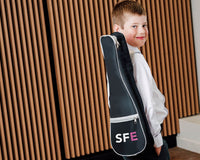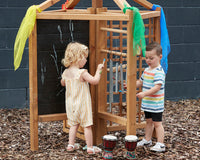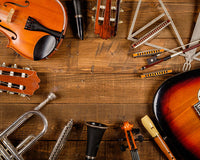So, you're here to find out which is the easiest brass instrument to learn? Well, we all have a love for music; either performing, wanting to perform, or merely listening and appreciating. Most of the staff here at Normans are musicians - we all have our own passion for a particular instrument and styles of music we love to listen to. Personally, I have the most eclectic of musical taste. Big Band, Brass Band, Jazz, Wind Band, 80’s Synth Pop, 2-Tone & Ska… and Elgar. Now that is some ‘variations’!
I told you it was eclectic!
So, of all the brass instruments available, which could be classed as ‘the easiest’? First and foremost, with all brass instruments, you have to learn to produce a sound with ‘the buzz’ of the pursed lips and compressed airflow. Once this has been achieved, it is then a case of how to change the pitch. Either through the technique of pressing/changing valve combinations, or slide positions, as well as the harmonic series (the notes achievable on a single position or valve by tightening or loosening the lips).
Classic Contenders
Let’s have a look at the most popular brass instruments, giving each an overview of the pros and cons of how easy they are to learn.
Cornet/Trumpet
The cheapest, smallest and lightest member of the brass family and easily the most popular. This popularity emphasises everything that is positive about choosing a Cornet or Trumpet to learn.
The affordable student Montreux Trumpet and Montreux Cornet are safe bets. The smaller size of the cornet makes it ideal for the younger player and as you find more of them in bands, better opportunity to perform!
Tenor Horn/French Horn
You may find that cornet/trumpet mouthpiece options are simply too small for your mouth shape/size (embouchure) and the ‘buzz’ will just not produce. In that case, the slightly larger and equally tonally pleasing option of a Tenor Horn or French Horn could be the answer.
Again, they are both affordable at the student, beginner level, with a Montreux Tenor Horn and a Montreux Mini-French Horn approx. £300-£400. The techniques are the same for all valve instruments and with practice, the lips and fingers will move in perfect sync to play the music.
Q: If a French Horn is so good… why stick your hand up the bell to stop the sound coming out??
A: It is this ‘stopping’ technique that produces the unique and powerful tone.
Baritone/Euphonium
The Baritone and Euphonium are the sweet and sonorous mainstay of the Brass Band Tenor Section (Euphonium players will tell you!). The Pavarottis of the band!
Due to their size, they would be more appropriate for an older student or adult.
As a first instrument to learn, the Montreux Student 3-Valve Euphonium and Montreux Bb Baritone, are both great-sounding and accessible to start you on your journey. Ideal for the developing and improving player who finally wants to own their own instrument. These beautiful instruments play as good as they look!
Designed and manufactured to high standards using pure brass, the tonal response and intonation will improve any enthusiastic player and section. The yellow-brass alloy will help your sound project across the venue, yet easily blend within the ensemble.
Trombone
Ahh, the wonderful, most amazing of instruments, the mighty Trombone. Simplistic in its design, with no valves to interfere with the most sonorous sound known to mankind! You can also get many more different sizes of Trombone mouthpieces (small or large shank) to accommodate varying embouchures. Ideal for all ages!
But to master this ‘brass-beauty’ takes dedication, patience and a total disregard for quieter instruments and the conductor!!
The trombone is an affordable brass instrument to learn, with models such as the brilliant Montreux Bb Trombone only costing around £200. A student I know gained his Grade 8 on one last year!
People have often asked me, “How do you know where to put the slide”? (I won’t tell you some of their suggestions!!) As with all instruments, especially strings, you simply practice and eventually gain hand-eye coordination and muscle memory that allows you to hit the right position every time. But the greatest asset a musician must have is an ear! You have to learn when you are in tune and when not… unless you play bagpipes, then just do your own thing regardless!
Tuba
The mighty Tuba, is on the official ‘endangered instruments’ list.
If you think about all of the other brass instruments mentioned, they’re all affordable and portable for all ages. Unfortunately, the tuba, be it an Eb tuba or the gargantuan Bb tuba, do not appeal to the younger players. This is due to ‘carryability’, cost (the cheapest model we stock is around £1000), and also, as the mouthpiece size can be much, much bigger than their mouth size, so creating a sound is unachievable.
However, for a potential player over the age of about 12, the tuba will offer you respect within a band/orchestra. Respect for your strength, your rarity and your deepest tones! The tuba is the foundation that all others rely on!!
Concisive (ish!) Conclusion!
Q: Which is the easiest brass instrument to learn?
A: They are all equal. Sorry, but it’s true!
If you choose an appropriate brass instrument that is suitable for your size, embouchure, budget and most importantly, your enthusiasm, you will prosper. Practice, dedication and a good teacher are also paramount in achieving the highest standards.
I have highlighted the best value-for-money range on offer from Montreux. If, however, you wish to achieve outstanding results quickly, with a much more impressive sound, I cannot recommend highly enough the professional spec range from the Montreux Concert Series. Stunning silver finish, design and sound quality. You will not be disappointed.
Now go forth my friends, buy a brass instrument and start the world domination over the woodwind section!




















